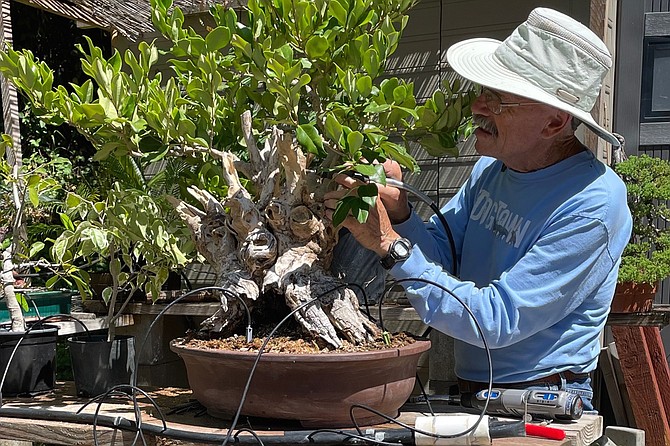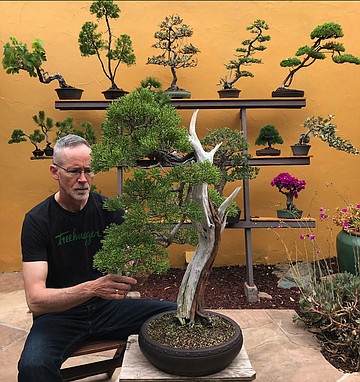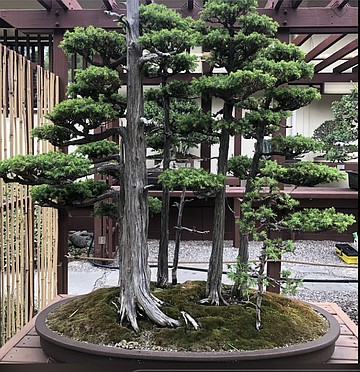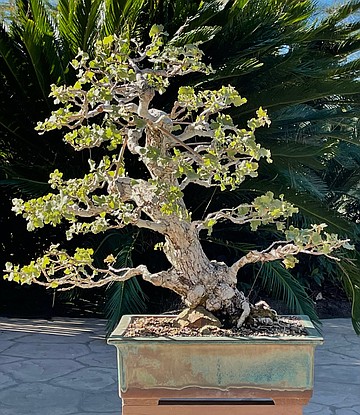 Facebook
Facebook
 X
X
 Instagram
Instagram
 TikTok
TikTok
 Youtube
Youtube

It is nine in the morning on a Wednesday, and within the confines of Balboa Park’s Japanese Friendship Garden, a few bonsai enthusiasts are moving quietly among the birds and the dew, tending to their trees. They are checking soil moisture, watering, weeding, pruning, and binding branches with wire. Today, they are also taking some time out of their usual activity to speak with me about the San Diego Bonsai Club and about the art of bonsai generally.

The club’s president, Ignacio De La Torre, is here, as is the curator of the Japanese Friendship Garden’s collection, Neil Auwarter. They are joined by Charlie Mosse, retired as both a nurseryman and county employee, who has been happily working in gardens since he was nine years old. All three are highly experienced, with many years of bonsai under their belts. All three have a patient, thoughtful demeanor that I am inclined to see as a side effect of the meditative, down-to-earth activity to which they are so devoted.
According to De La Torre, the SDBC is the largest such club in the United States. “Some have said the largest in the world, which is quite possible. Last year, we ended the year with about 500 paid members. Most clubs around the U.S. probably have 35-50 members.” An average meeting, held at the Casa del Prado, a stone’s throw from where we stand, will generally involve about 70 people representing a wide age range; there are members in their twenties, and others in their nineties. “One of the advantages that we have is the two collections that we maintain. The one here in the Garden and the one in the Safari Park. You go to the Safari Park to see animals, and all of a sudden you come across this beautiful pavilion of miniature trees and you’re fascinated by that, and you want to know more. I think we’re able to generate a lot of membership because of the collections.” In addition to the collections, there are two annual shows — one in the Spring (April 23 and 24 this year at the Casa del Prado), and another in the Fall — which bring in thousands of viewers and also generate a good deal of interest in bonsai.

Practical teaching is a major emphasis of the club. Explains De La Torre, “We have teachers within the club and teachers who we bring from outside of the club who are experts, and our club members enjoy that aspect of it.” He says that “at any club meeting, we might have a high level instructor from within the club, or from outside of the club coming in to talk to the membership.”
That opportunity for learning is part of the reason for forming a club around the sort of ancient, meditative practice that one might consider best suited to solitary practice. Neil Auwarter compares the beneficial effects of being part of the SDBC to crowdsourcing. “If you do something on your own, you’re limited to the quality of the trees that you can create,” he says. But the club put him in touch with experience, knowledge, and trees far beyond what he could work with individually. He mentions the highlight of getting to work with a “legacy tree” at the Safari Park collection that has been in cultivation for 400 years. “You can’t do that if you’re in a silo, doing your own thing by yourself”.
As most everyone knows, bonsai is an art that involves the growing and shaping of miniature trees. That essential element, De La Torre notes, is what often draws people to it. It is part of what is inherently pleasing about bonsai. “People like to look at miniatures of large things,” Auwarter says. He compares the miniaturized tree to a “reduction of sauce in cooking. It’s the same sauce, but you’ve distilled it down, so it’s a stronger sensory experience.” At this size, the entirety of the tree can be viewed at once: trunk, branches, leaves, soil, pot.

But the carefully managed size of the bonsai is only one of many elements involved in cultivation; there are many other desired formal qualities. Charlie Mosse mentions the plates of bark on you might find rough old trees. “We’re also trying to create age,” he says, “and age takes time.” In addition to the small scale of the trees, the evocation of a sense of age and the passage of time is an essential element of the art. The roots, the tapering of a trunk, the gnarled limbs — all these display the passage of time. So does damage; for instance, there is the inclusion of dead wood on the Bonsai, distinguished from its living counterpart by its ghostly paleness.
Auwarter repeats the notion that “Bonsai is art in four dimensions: the three spatial dimensions plus time”. He says that “a good tree tells the story of its life”, and he relates the expressive features of the tree to a key idea in Japanese aesthetics, that of wabi-sabi, which he summarizes as “embracing the idea of impermanence, incompleteness, and imperfection. Nothing is finished, nothing is perfect, and nothing lasts. And it goes along with an appreciation for things that are old: asymmetry, age, and sometimes, breakdown”.
Mosse adds that “creating bonsai really is a journey. To create real, quality bonsai takes about a minimum of 10 years. The better pieces have been in cultivation for 20, 30, 40 years.” He says that one group member has in fact been working with the same tree for more than 40 years now. Concludes De La Torre, “There is a belief in bonsai that one is never finished with a tree. You’re merely in the process of developing it, and you will hand it off to someone else to be developed. Unlike a piece of art that is finished and you won’t touch again, these continue to grow. You must do something to keep it alive, and it’s going to change over time.”


It is nine in the morning on a Wednesday, and within the confines of Balboa Park’s Japanese Friendship Garden, a few bonsai enthusiasts are moving quietly among the birds and the dew, tending to their trees. They are checking soil moisture, watering, weeding, pruning, and binding branches with wire. Today, they are also taking some time out of their usual activity to speak with me about the San Diego Bonsai Club and about the art of bonsai generally.

The club’s president, Ignacio De La Torre, is here, as is the curator of the Japanese Friendship Garden’s collection, Neil Auwarter. They are joined by Charlie Mosse, retired as both a nurseryman and county employee, who has been happily working in gardens since he was nine years old. All three are highly experienced, with many years of bonsai under their belts. All three have a patient, thoughtful demeanor that I am inclined to see as a side effect of the meditative, down-to-earth activity to which they are so devoted.
According to De La Torre, the SDBC is the largest such club in the United States. “Some have said the largest in the world, which is quite possible. Last year, we ended the year with about 500 paid members. Most clubs around the U.S. probably have 35-50 members.” An average meeting, held at the Casa del Prado, a stone’s throw from where we stand, will generally involve about 70 people representing a wide age range; there are members in their twenties, and others in their nineties. “One of the advantages that we have is the two collections that we maintain. The one here in the Garden and the one in the Safari Park. You go to the Safari Park to see animals, and all of a sudden you come across this beautiful pavilion of miniature trees and you’re fascinated by that, and you want to know more. I think we’re able to generate a lot of membership because of the collections.” In addition to the collections, there are two annual shows — one in the Spring (April 23 and 24 this year at the Casa del Prado), and another in the Fall — which bring in thousands of viewers and also generate a good deal of interest in bonsai.

Practical teaching is a major emphasis of the club. Explains De La Torre, “We have teachers within the club and teachers who we bring from outside of the club who are experts, and our club members enjoy that aspect of it.” He says that “at any club meeting, we might have a high level instructor from within the club, or from outside of the club coming in to talk to the membership.”
That opportunity for learning is part of the reason for forming a club around the sort of ancient, meditative practice that one might consider best suited to solitary practice. Neil Auwarter compares the beneficial effects of being part of the SDBC to crowdsourcing. “If you do something on your own, you’re limited to the quality of the trees that you can create,” he says. But the club put him in touch with experience, knowledge, and trees far beyond what he could work with individually. He mentions the highlight of getting to work with a “legacy tree” at the Safari Park collection that has been in cultivation for 400 years. “You can’t do that if you’re in a silo, doing your own thing by yourself”.
As most everyone knows, bonsai is an art that involves the growing and shaping of miniature trees. That essential element, De La Torre notes, is what often draws people to it. It is part of what is inherently pleasing about bonsai. “People like to look at miniatures of large things,” Auwarter says. He compares the miniaturized tree to a “reduction of sauce in cooking. It’s the same sauce, but you’ve distilled it down, so it’s a stronger sensory experience.” At this size, the entirety of the tree can be viewed at once: trunk, branches, leaves, soil, pot.

But the carefully managed size of the bonsai is only one of many elements involved in cultivation; there are many other desired formal qualities. Charlie Mosse mentions the plates of bark on you might find rough old trees. “We’re also trying to create age,” he says, “and age takes time.” In addition to the small scale of the trees, the evocation of a sense of age and the passage of time is an essential element of the art. The roots, the tapering of a trunk, the gnarled limbs — all these display the passage of time. So does damage; for instance, there is the inclusion of dead wood on the Bonsai, distinguished from its living counterpart by its ghostly paleness.
Auwarter repeats the notion that “Bonsai is art in four dimensions: the three spatial dimensions plus time”. He says that “a good tree tells the story of its life”, and he relates the expressive features of the tree to a key idea in Japanese aesthetics, that of wabi-sabi, which he summarizes as “embracing the idea of impermanence, incompleteness, and imperfection. Nothing is finished, nothing is perfect, and nothing lasts. And it goes along with an appreciation for things that are old: asymmetry, age, and sometimes, breakdown”.
Mosse adds that “creating bonsai really is a journey. To create real, quality bonsai takes about a minimum of 10 years. The better pieces have been in cultivation for 20, 30, 40 years.” He says that one group member has in fact been working with the same tree for more than 40 years now. Concludes De La Torre, “There is a belief in bonsai that one is never finished with a tree. You’re merely in the process of developing it, and you will hand it off to someone else to be developed. Unlike a piece of art that is finished and you won’t touch again, these continue to grow. You must do something to keep it alive, and it’s going to change over time.”
Comments